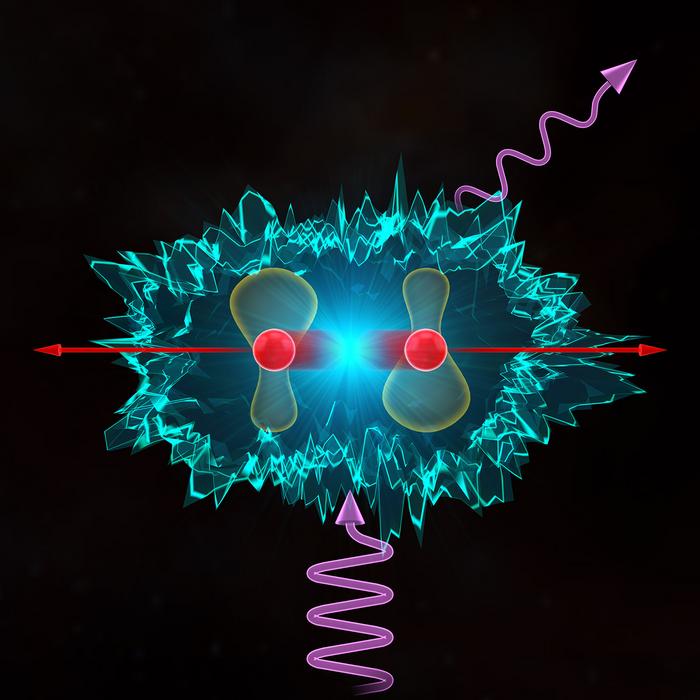
In a groundbreaking study recently published in Physical Review Letters, researchers from JILA and the University of Colorado Boulder have embarked on an exploration of light-assisted collisions involving rubidium atoms, uncovering key insights into the intricate dance of quantum mechanics at play in ultracold temperatures. As atoms collide in this near-zero Kelvin environment, their quantum properties, such as electron configuration and nuclear spin, become pivotal factors in the outcomes of these interactions. This research not only charts new territory in atomic collision dynamics but also establishes a new framework for understanding the complexities of atomic manipulation using light.
The phenomenon of light-assisted collisions presents a fascinating challenge in quantum science. When laser light interacts with cold atoms, it can initiate collisions that lead to the formation of transient molecular states. These are not merely playful interactions; they can release significant amounts of energy, reshaping our understanding of atomic behavior under such extreme conditions. Historically, although the broad strokes of these processes have been outlined in prior works, much about the underlying mechanics involved remained shrouded in uncertainty. This study promises to lift the veil on those complexities.
At the heart of this research are the advanced techniques used to observe and measure the time-sensitive dynamics of atom-atom collisions in optical tweezers. By leveraging cutting-edge optical trapping technology, the team managed to isolate individual atoms, providing a unique vantage point from which to analyze their collisions. This approach is not merely an academic exercise; it’s crucial for applications in quantum technology, particularly in the design and operation of quantum computers where control at the atomic level is paramount.
One of the exciting aspects of this research is the involvement of hyperfine structure in determining how light influences collisions. Hyperfine structure refers to the small energy differences arising from the interactions between an atom’s nucleus and its surrounding electrons. Understanding these differences could unlock new methods for guiding the outcomes of atomic collisions and ultimately offers a tool for managing energy release. As the team varies the frequency of the laser light — akin to adjusting the power of a cue ball in billiards — they can observe how changes in photon energy affect collision rates and energy dynamics.
Graduate student Steven Pampel, the first author of the study, articulated the complexities involved in developing a precise model for light-assisted collisions under varying conditions. Conditions such as light frequency have a disproportionately large influence on the results. With each fine-tuned experiment, Pampel and the team observed how energy dynamics manifested differently based on these hyperfine interactions, revealing unforseen consequences and stimulating further research questions.
Moreover, the researchers took the extra step of implementing an innovative imaging technique designed to minimize the disruption typically caused during standard observation methods. In typical optical tweezers setups, the mere act of photographing atoms could displace them, compromising the integrity of the measurements. The novel imaging solution proposed by the JILA research team ensures that while observing the atoms, they can maintain their confinement, allowing for accurate assessment of their states post-collision.
In their pursuit of understanding light-assisted collisions, the study also builds on several decades of prior research, including foundational work by Allan Gallagher and his collaborators, who laid the groundwork for much of the existing knowledge in the field. However, the previous models primarily relied on large ensembles of atoms, leading to limitations that restricted clear control over variables such as laser frequency. By focusing on individual atom interactions, this research shifts the paradigm toward precision and clarity.
What sets this study apart is not just its experimental results but also the theoretical framework devised to interpret the data collected. As the researchers mapped potential energy curves for colliding rubidium atoms while accounting for hyperfine interactions, they revealed the complexities that occur beyond the classical expectations. This sophisticated analysis not only elucidates the various paths a collision can take but also holds implications for future research in other atomic systems beyond rubidium.
As quantum technology continues to evolve, the applications of this research could extend to numerous fields, from quantum computing to metrology, where precision at the atomic level can make or break advancements. Any improvement in understanding how atomic collisions behave based on hyperfine structure could lead to substantial enhancements in methodologies for laser cooling and manipulation of atomic states. Such advancements may create a ripple effect across several applications, leading to breakthroughs in quantum-based technologies that have yet to be imagined.
The implications of this research reach far beyond the confines of traditional physics. Our comprehension of quantum mechanics and how light can orchestrate atomic interactions presents an exciting opportunity for the next leap in technology. As scientists refine these techniques and integrate them with existing technologies, we may soon witness a new era of quantum applications that operate with unprecedented efficiency and precision.
In summary, this study not only unravels the mystery of light-assisted collisions but also sets a clear path toward future research that could reshape our approach to atomic manipulation. The collective efforts of Cindy Regal, Steven Pampel, and their colleagues represent a vital step forward in our understanding of quantum interactions; one that may propel the science of quantum mechanics into practical applications that can elevate technology into new realms of possibility.
Subject of Research: Light-Assisted Collisions in Ultracold Atoms
Article Title: Quantifying Light-Assisted Collisions in Optical Tweezers across the Hyperfine Spectrum
News Publication Date: 10-Jan-2025
Web References: Physical Review Letters
References: 10.1103/PhysRevLett.134.013202
Image Credits: Steven Burrows, Steven Pampel, and Cindy Regal
Keywords
Quantum mechanics, Quantum information science, Quantum systems, Light-assisted collisions, Hyperfine structure.
Tags: advanced measurement techniques in quantum researchatomic manipulation using laser lightcomplexities of quantum collision dynamicsenergy release in atomic collisionsgroundbreaking studies in quantum scienceJILA and University of Colorado Boulder researchlight-assisted atomic collisionsPhysical Review Letters publicationquantum properties of atomsrubidium atom interactionstransient molecular state formationultracold temperature quantum mechanics





